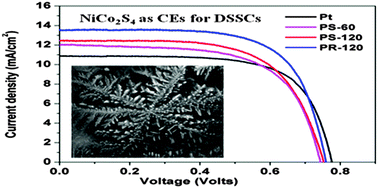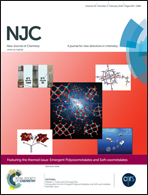Pulse reverse electrodeposited NiCo2S4 nanostructures as efficient counter electrodes for dye-sensitized solar cells
Abstract
Dendritic nanostructures of NiCo2S4 were deposited onto a transparent conducting glass substrate by a facile one step electrodeposition method and were used as counter electrodes (CEs) for dye-sensitized solar cells (DSSCs). The NiCo2S4 thin films were deposited by both potentiostatic (PS) and pulse reverse (PR) electrodeposition techniques and characterized using X-ray diffraction (XRD), scanning electron microscopy (SEM), electrochemical impedance spectroscopy (EIS) and cyclic voltammetry (CV). Both PS and PR techniques produced dendrite-like NiCo2S4 nanostructures. CV and EIS measurements revealed excellent electrocatalytic activities for the I−/I3− redox reaction for DSSCs. Sequential CV scanning further showed the high electrochemical stability of the NiCo2S4 dendritic nanostructures. The CEs prepared by the PR and PS techniques displayed power conversion efficiency of 7.03% and 6.01%, respectively, which are better than in the control device with thermally deposited Pt. Due to the large surface area of the NiCo2S4 dendrite structures and high electrocatalytic activity towards the reduction of I3− to I−, the electrodes demonstrated high solar cell conversion efficiency. This simple and low cost electrodeposition technique shows promise for large scale production of environmentally friendly and highly efficient NiCo2S4 CEs for DSSC applications.



 Please wait while we load your content...
Please wait while we load your content...